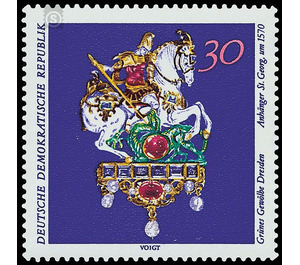Artworks from the Green Vault in Dresden - Germany / German Democratic Republic 1971 - 30 Pfennig
Theme: Devices, Items & Instruments
| Country | Germany / German Democratic Republic |
| Issue Date | 1971 |
| Face Value | 30.00 |
| Color | blue |
| Perforation | K 13 |
| Printing Type | Photogravure |
| Stamp Type | Postage stamp |
| Item Type | Stamp |
| Chronological Issue Number | 1429 |
| Chronological Chapter | GER-DDR |
| SID | 284461 |
| In 25 Wishlists | |
Works of art from the Green Vault in Dresden The Ministry of Posts and Telecommunications of the German Democratic Republic publishes a series of six multicolored special postage stamps depicting works of art from the Green Vault in Dresden. Works of Art from the Green Vault in Dresden The Green Vault was the treasury of the Saxon Electors and Kings. The name of the collection can be derived from a vaulted and green painted room in the Dresden Residenzschloss, which was used as a safe by the territorial lords since the 16th century. In 1721, the aforementioned vault room was connected with the adjoining rooms, where the first treasury museum in Europe was established. For the new collection was selected, which was precious, rare and decorative: works of gold, silver, precious stones, ivory, ebony, amber, colored glass, etc. The scope of this treasure, which is considered the richest gem collection in the world, is to explain The fact that Saxony was one of the wealthiest countries in the world for centuries due to the mineral wealth of the Erzgebirge and its early developed industry. The collection was outsourced in 1942 to the fortress Königstein. On February 13, 1945, the castle burned down with the inner city of Dresden, but of the old treasure vaults, which were considered particularly safe since the 16th century, most were preserved with only minor damage. After the capitulation of the Nazi Empire, Soviet special forces secured the outsourced treasure against looting and transferred him to Moscow. In this way, the unique collection was completely preserved. In 1958, the Green Vault was handed back to the German people, and since the following year about 400 of the most important works of art (15 percent) are shown in the Albertinum in Dresden. The government of the GDR gave the museum immediate support to take up its folk educational, scientific and restoration functions. After the planned construction of the Dresden Residenzschloss as a museum center, the collection will relocate the restored rooms, from which it takes its name. The battle of the good against the evil, represented by the figure of the holy knight Georg, who kills the dragon, shows the pendant on the 30-pfennig mark. The work of art was made of gold by an unknown Southern German master around 1570, splendidly enamelled and set with diamonds, rubies and pearls. A ruby represents the wound in the body of the dragon.


